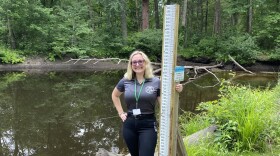Students at Keene State University are using a flat aquatic worm to study some rare human diseases. And the research began because of something unexpected that occurred in the course of some very basic research.
David Brooks is a reporter for the Concord Monitor and writer at Granitegeek.org. He joined NHPR’s Peter Biello to discuss the story behind this flatworm research.
The research that the students at Keene State University are doing evolved out of something that happened in an Intro to Biology course in 2010. Tell us what happened in that course.
To the layman at least, that’s perhaps the most interesting part of the story. This cutting-edge biomedical research came out of an unlikely place, which was a “Gen-Ed” course in biology: a course for non-science majors who needed to get requirements out of the way. Dr. Jason Pellettieri thought, “let’s get these kids excited about science.” So he created some experiments with flatworms, or “Planaria,” as they are officially known.
Flatworms are aquatic worms that are, oddly enough, flat. They are very common in biology research, largely because they regenerate quickly. If you cut off parts of them, they regrow very easily. They’ve been studied quite a lot because they can teach us things about how we can heal ourselves. They are very common, cheap, and easy to take care of.
So Dr. Pellettieri gave the kids Planaria, and had them design an experiment for regeneration. It could be something like pouring energy drinks into their water to see how that affects their regeneration. One group of students wanted to know how light affected them, so they put a tray of these worms up on the windowsill (normally they are kept out of the light because they don’t like heat). They were left up there too long, and when the students came back, they found the worms were white, instead of their usual reddish-brown. They had lost all their color, which Dr. Pellettierei had never seen before. He thought, “well that’s really interesting; I wonder what caused that.” He didn’t know. He had courses to teach and research to do, and he put it aside.
But a student took up the mantle and ran with it. And here we are, six years later, and that research has continued into how these flatworms can be useful in studying things like skin pigment change, sensitivity to light, and facial hair growth.
You’re right. Another student came asking for a research project, and Dr. Pellettieri said, “I know what you can do.” And that student, Bradford Stubenhaus, took it, ran with it, and turned it into real research.
Stubenhaus found that the underlying chemical process happening in the flatworms was the same as one happening in human tissue in a particular rare disease. So he found that you can use flatworms as an animal model for what’s happening in humans. You can test drugs with flatworms to see whether it alters the pigmentation change. You can do it easily by just dropping the chemical into the water with them. There are no mice to keep alive or fur to shave; the flatworms just absorb the chemical. It’s a good, cheap, effective animal model that could lead to some new treatments and understanding of these diseases.
Has this research team come up with any possible new treatments?
Not yet; they are still in the process. This is slow stuff. This is real science research. And this can take a long time; it’s very complicated. But they’ve pulled in six figures worth of funding from the Federal Government because it’ that promising. They’ve got several full-time people employed in the lab, keeping these flatworms alive. They’ve found the worms do best under red led lights, so the lab is full of red lights. Apparently at night, looking up at the windows, it’s like some night club up there, with all the funky lights. “Club Planaria.”
It is also interesting to note that so much in science depends on simply keeping an open mind, and being aware of so-called “mistakes” that may present other implications.
Exactly. If Jason Pellettieri hadn’t been aware that it was unusual for the worms to be blanched, if he wasn’t knowledgeable enough to realize that was unusual, it wouldn’t have stuck with him. He wouldn’t have thought of it when Stubenhaus came to ask for a project.
It’s the perfect example of Louis Pasteur’s line, which is, “fortune favors the prepared mind.” Dumb luck doesn’t really help you unless you’re smart enough to know that it’s helpful.








